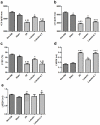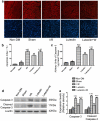Luteolin limits infarct size and improves cardiac function after myocardium ischemia/reperfusion injury in diabetic rats
- PMID: 22432030
- PMCID: PMC3303839
- DOI: 10.1371/journal.pone.0033491
Luteolin limits infarct size and improves cardiac function after myocardium ischemia/reperfusion injury in diabetic rats
Abstract
Background: The present study was to investigate the effects and mechanism of Luteolin on myocardial infarct size, cardiac function and cardiomyocyte apoptosis in diabetic rats with myocardial ischemia/reperfusion (I/R) injury.
Methodology/principal findings: Diabetic rats underwent 30 minutes of ischemia followed by 3 h of reperfusion. Animals were pretreated with or without Luteolin before coronary artery ligation. The severity of myocardial I/R induced LDH release, arrhythmia, infarct size, cardiac function impairment, cardiomyocyte apoptosis were compared. Western blot analysis was performed to elucidate the target proteins of Luteolin. The inflammatory cytokine production were also examined in ischemic myocardium underwent I/R injury. Our results revealed that Luteolin administration significantly reduced LDH release, decreased the incidence of arrhythmia, attenuated myocardial infarct size, enhanced left ventricular ejection fraction and decreased myocardial apoptotic death compared with I/R group. Western blot analysis showed that Luteolin treatment up-regulated anti-apoptotic proteins FGFR2 and LIF expression, increased BAD phosphorylation while decreased the ratio of Bax to Bcl-2. Luteolin treatment also inhibited MPO expression and inflammatory cytokine production including IL-6, IL-1a and TNF-a. Moreover, co-administration of wortmannin and Luteolin abolished the beneficial effects of Luteolin.
Conclusions/significance: This study indicates that Luteolin preserves cardiac function, reduces infarct size and cardiomyocyte apoptotic rate after I/R injury in diabetic rats. Luteolin exerts its action by up-regulating of anti-apoptotic proteins FGFR2 and LIF expression, activating PI3K/Akt pathway while increasing BAD phosphorylation and decreasing ratio of Bax to Bcl-2.
Conflict of interest statement
Figures






References
-
- Donahoe SM, Stewart GC, McCabe CH, Mohanavelu S, Murphy SA, et al. Diabetes and mortality following acute coronary syndromes. Jama. 2007;298:765–775. - PubMed
-
- Third Report of the National Cholesterol Education Program (NCEP) Expert Panel on Detection, Evaluation, and Treatment of High Blood Cholesterol in Adults (Adult Treatment Panel III) final report. Circulation. 2002;106:3143–3421. - PubMed
-
- Liang JL, Xiao DZ, Liu XY, Lin QX, Shan ZX, et al. High glucose induces apoptosis in AC16 human cardiomyocytes via macrophage migration inhibitory factor and c-Jun N-terminal kinase. Clin Exp Pharmacol Physiol. 2010;37:969–973. - PubMed
-
- Wu Y, Xia ZY, Dou J, Zhang L, Xu JJ, et al. Protective effect of ginsenoside Rb1 against myocardial ischemia/reperfusion injury in streptozotocin-induced diabetic rats. Mol Biol Rep. 2011;38:4327–4335. - PubMed
Publication types
MeSH terms
Substances
LinkOut - more resources
Full Text Sources
Medical
Research Materials
Miscellaneous

